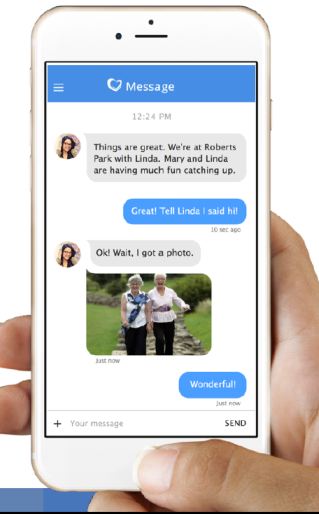Watching an older parent age and become more frail and vulnerable is hard for many of the 44 million American family caregivers of those over the age of 50. As our parent held our hands to balance our steps, made our meals, bathed us, etc. many adult children find themselves in this same position helping and caring for an aging parent. But, getting quality help with activities of daily living (called ADLs) in order to keep a parent at home as long as possible can not only be affordable but can give everyone – mom or dad and the adult child caregiver – a sense of safety, security and satisfaction.
I have found in the 12 years I have worked in caregiving and aging that having the conversation with our older loved ones about their long-term care or aging in place needs is one of the most difficult discussions we encounter in life – for both parents and adult children. Our need to deny the challenges facing a parent that comes with the bonus years we call “longevity” and their twin needs of not burdening us and not feeling a loss of control and freedom, often make this a conversation we all skip.
In my research talking to both family and professional caregivers, I have come across some insights and tips on how to have the conversation with a parent about securing in-home care. The typical responses are that it is not affordable, the parent doesn’t want a stranger coming into their home or they just won’t admit they need the extra help whether it is cleaning the house, washing the dishes, preparing a meal, getting to the grocery store, taking a stroll around the block, etc.
 As an advisor to CareLinx, the nation’s largest online caregiver marketplace, I have talked with the CareLinx professionals on how this conversation can take on a different tone and emphasis when it’s dad versus mom we’re with whom we’re having “the talk”:
As an advisor to CareLinx, the nation’s largest online caregiver marketplace, I have talked with the CareLinx professionals on how this conversation can take on a different tone and emphasis when it’s dad versus mom we’re with whom we’re having “the talk”:
The Caregiving Conversation with Dads
Although it sounds stereotypical, most of our fathers (if you are a Baby Boom or Gen X adult) were the head of the household. Many young children can repeat the refrain from our mothers when we misbehaved, “Wait until your father gets home.” Fathers see their role as protecting and providing for their families. Thus, our aging fathers find themselves in new territory when it is them needing the care.
According to research professor and author Carol Gilligan who has focused her studies on on gender differences (In A Different Voice), fathers sometimes have a harder time accepting change. Their fear of change is that it may mean they are not in control, they may not be consulted on decisions and they are not strong enough to perform daily activities without help. On the flip side, a study conducted by Northwestern Mutual found that more fathers talk to their adult children about their long-term care plans and wishes than our mothers.
Given these two data points, a wise adult child caregiver may take this two-pronged approach in a conversation with Dad about in-home care:
- Focus on not calling the in-home caregiver a “caregiver.” Rather convince dad he needs a personal assistant around the house. This puts him in a supervisory, directorial role. Instead of feeling vulnerable he feels he is in charge. Also, tell him with the CareLinx service, he gets to choose who comes to the home instead of traditional agencies which just send out an available care professional. This lets him know he is in control.
- In addition, show him the CareLinx web site where you can see that using the CareLinx online caregiver marketplace for in-home care saves 30-50 percent over traditional agencies. He’ll feel like he’s still protecting and providing for his family by making a great deal on the care help needed.
 The Caregiving Conversation with Moms
The Caregiving Conversation with Moms
For aging moms, financial security and safety while living alone become primary concerns. According to WISER (Women for a Secure Retirement), 40 percent of women over age 65 rely solely on Social Security benefits as their only source of retirement income. In addition, the U.S. Administration on Aging reports that 47 percent of women over age 75 live alone at home.
Enter CareLinx to help you assuage mom’s concerns about costs of in-home care and give her the security in knowing she is protected by having an outside care professional who comes into her home. As stated above, CareLinx saves considerably on costs of traditional agencies. The average family spends $100,000 on in-home care (over the time period care is needed) so saving 30-50 percent of this cost makes an unaffordable service suddenly affordable. And, with CareLinx’s $4 million Safeguard Policy backed by Lloyds of London, along with the thorough background checks conducted on its 150,000 network of care professionals nationwide, CareLinx offers mom a sense of security and safety that you cannot guarantee if you find a care professional through an online forum such as Craig’s List.
When it comes to having the caregiving conversation about in-home care with mom or dad, knowing what is important to them makes all the difference in the world.
Special offer for Elder Guru Readers:
Click on this link: CareLinx and receive 4 cost-free complimentary hours of in-home care from CareLinx throughout the month of July.
About Sherri Snelling
Sherri Snelling is CEO of Caregiving Club and author of A Cast of Caregivers – Celebrity Stories to Help You Prepare to Care and she writes on caregiving for PBS Next Avenue, Forbes.com, USA Today and Huffington Post. She was the chairman of the National Alliance for Caregiving and has served on advisory groups for the White House Middle Class Task Force on Caregiving, CMS, AARP as well as for companies such as CareLinx.
Disclaimer: Sherri Snelling is a paid advisory board member of CareLinx. While her strategic counsel, spokesperson and other duties are paid by CareLinx, Sherri Snelling is not paid for clicks or links such as an affiliated marketing arrangement. While Sherri Snelling provides her opinion of CareLinx, she does not guarantee the quality and satisfaction of the CareLinx services experienced by individual CareLinx client and thus, disclaims any liability that may result from your involvement with CareLinx.
